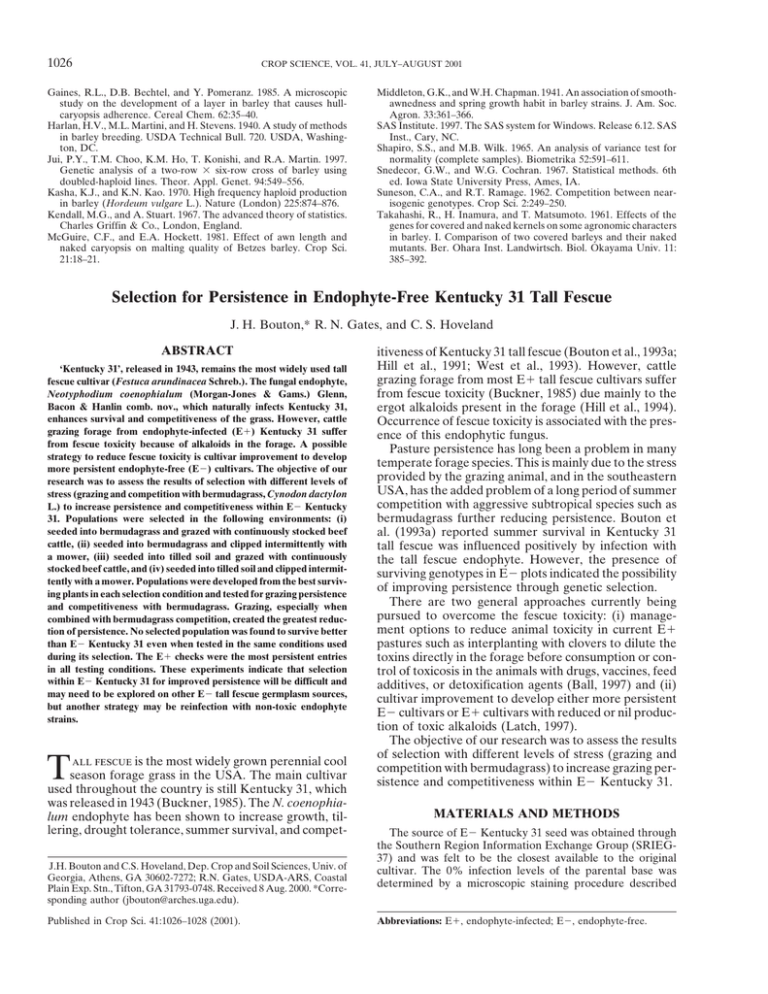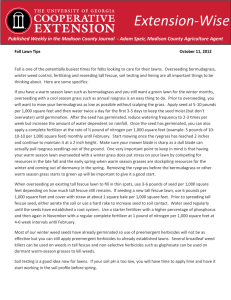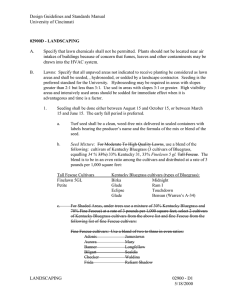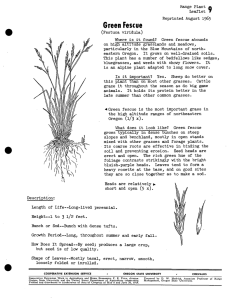22711 - PubAg
advertisement

1026 CROP SCIENCE, VOL. 41, JULY–AUGUST 2001 Gaines, R.L., D.B. Bechtel, and Y. Pomeranz. 1985. A microscopic study on the development of a layer in barley that causes hullcaryopsis adherence. Cereal Chem. 62:35–40. Harlan, H.V., M.L. Martini, and H. Stevens. 1940. A study of methods in barley breeding. USDA Technical Bull. 720. USDA, Washington, DC. Jui, P.Y., T.M. Choo, K.M. Ho, T. Konishi, and R.A. Martin. 1997. Genetic analysis of a two-row ⫻ six-row cross of barley using doubled-haploid lines. Theor. Appl. Genet. 94:549–556. Kasha, K.J., and K.N. Kao. 1970. High frequency haploid production in barley (Hordeum vulgare L.). Nature (London) 225:874–876. Kendall, M.G., and A. Stuart. 1967. The advanced theory of statistics. Charles Griffin & Co., London, England. McGuire, C.F., and E.A. Hockett. 1981. Effect of awn length and naked caryopsis on malting quality of Betzes barley. Crop Sci. 21:18–21. Middleton, G.K., and W.H. Chapman. 1941. An association of smoothawnedness and spring growth habit in barley strains. J. Am. Soc. Agron. 33:361–366. SAS Institute. 1997. The SAS system for Windows. Release 6.12. SAS Inst., Cary, NC. Shapiro, S.S., and M.B. Wilk. 1965. An analysis of variance test for normality (complete samples). Biometrika 52:591–611. Snedecor, G.W., and W.G. Cochran. 1967. Statistical methods. 6th ed. Iowa State University Press, Ames, IA. Suneson, C.A., and R.T. Ramage. 1962. Competition between nearisogenic genotypes. Crop Sci. 2:249–250. Takahashi, R., H. Inamura, and T. Matsumoto. 1961. Effects of the genes for covered and naked kernels on some agronomic characters in barley. I. Comparison of two covered barleys and their naked mutants. Ber. Ohara Inst. Landwirtsch. Biol. Okayama Univ. 11: 385–392. Selection for Persistence in Endophyte-Free Kentucky 31 Tall Fescue J. H. Bouton,* R. N. Gates, and C. S. Hoveland ABSTRACT ‘Kentucky 31’, released in 1943, remains the most widely used tall fescue cultivar (Festuca arundinacea Schreb.). The fungal endophyte, Neotyphodium coenophialum (Morgan-Jones & Gams.) Glenn, Bacon & Hanlin comb. nov., which naturally infects Kentucky 31, enhances survival and competitiveness of the grass. However, cattle grazing forage from endophyte-infected (E⫹) Kentucky 31 suffer from fescue toxicity because of alkaloids in the forage. A possible strategy to reduce fescue toxicity is cultivar improvement to develop more persistent endophyte-free (E⫺) cultivars. The objective of our research was to assess the results of selection with different levels of stress (grazing and competition with bermudagrass, Cynodon dactylon L.) to increase persistence and competitiveness within E⫺ Kentucky 31. Populations were selected in the following environments: (i) seeded into bermudagrass and grazed with continuously stocked beef cattle, (ii) seeded into bermudagrass and clipped intermittently with a mower, (iii) seeded into tilled soil and grazed with continuously stocked beef cattle, and (iv) seeded into tilled soil and clipped intermittently with a mower. Populations were developed from the best surviving plants in each selection condition and tested for grazing persistence and competitiveness with bermudagrass. Grazing, especially when combined with bermudagrass competition, created the greatest reduction of persistence. No selected population was found to survive better than E⫺ Kentucky 31 even when tested in the same conditions used during its selection. The E⫹ checks were the most persistent entries in all testing conditions. These experiments indicate that selection within E⫺ Kentucky 31 for improved persistence will be difficult and may need to be explored on other E⫺ tall fescue germplasm sources, but another strategy may be reinfection with non-toxic endophyte strains. T all fescue is the most widely grown perennial cool season forage grass in the USA. The main cultivar used throughout the country is still Kentucky 31, which was released in 1943 (Buckner, 1985). The N. coenophialum endophyte has been shown to increase growth, tillering, drought tolerance, summer survival, and compet- J.H. Bouton and C.S. Hoveland, Dep. Crop and Soil Sciences, Univ. of Georgia, Athens, GA 30602-7272; R.N. Gates, USDA-ARS, Coastal Plain Exp. Stn., Tifton, GA 31793-0748. Received 8 Aug. 2000. *Corresponding author (jbouton@arches.uga.edu). Published in Crop Sci. 41:1026–1028 (2001). itiveness of Kentucky 31 tall fescue (Bouton et al., 1993a; Hill et al., 1991; West et al., 1993). However, cattle grazing forage from most E⫹ tall fescue cultivars suffer from fescue toxicity (Buckner, 1985) due mainly to the ergot alkaloids present in the forage (Hill et al., 1994). Occurrence of fescue toxicity is associated with the presence of this endophytic fungus. Pasture persistence has long been a problem in many temperate forage species. This is mainly due to the stress provided by the grazing animal, and in the southeastern USA, has the added problem of a long period of summer competition with aggressive subtropical species such as bermudagrass further reducing persistence. Bouton et al. (1993a) reported summer survival in Kentucky 31 tall fescue was influenced positively by infection with the tall fescue endophyte. However, the presence of surviving genotypes in E⫺ plots indicated the possibility of improving persistence through genetic selection. There are two general approaches currently being pursued to overcome the fescue toxicity: (i) management options to reduce animal toxicity in current E⫹ pastures such as interplanting with clovers to dilute the toxins directly in the forage before consumption or control of toxicosis in the animals with drugs, vaccines, feed additives, or detoxification agents (Ball, 1997) and (ii) cultivar improvement to develop either more persistent E⫺ cultivars or E⫹ cultivars with reduced or nil production of toxic alkaloids (Latch, 1997). The objective of our research was to assess the results of selection with different levels of stress (grazing and competition with bermudagrass) to increase grazing persistence and competitiveness within E⫺ Kentucky 31. MATERIALS AND METHODS The source of E⫺ Kentucky 31 seed was obtained through the Southern Region Information Exchange Group (SRIEG37) and was felt to be the closest available to the original cultivar. The 0% infection levels of the parental base was determined by a microscopic staining procedure described Abbreviations: E⫹, endophyte-infected; E⫺, endophyte-free. 1027 BOUTON ET AL.: SELECTION FOR PERSISTENCE IN ENDOPHYTE-FREE TALL FESCUE by Bacon et al. (1977) on a random sample of 100 8-wkold seedlings. This selection experiment was conducted at Tifton, GA, on a Tifton sandy loam soil (fine-loamy, siliceous, thermic, Plintic Kandiudult). The experimental site was well established in bermudagrass with the predominate type being ‘Coastal’. This site was divided into two adjacent areas: (i) a grazed area (approximately 0.75 ha) stocked with enough beef cattle to achieve a constant grazing height of 7.5 to 12.5 cm (“graze” treatment) and (ii) hay production area (approximately 0.25 ha) isolated with electric fence (“clipped” treatment). Two tall fescue cultivars, Kentucky 31 (E⫺) and Georgia 5 (E⫹) (Bouton et al., 1993b), were sown at 28 kg seed ha⫺1 in October, 1991 in 3-m by 6-m plots randomized within each of the following planting method strips within both the graze and clipped areas: (i) bermudagrass strips killed with glyphosate herbicide [N-(phosphonomethyl) glycine], plowed and harrowed, and cultivars seeded with a cultipak seeder (“till” treatment) or (ii) cultivars sod-seeded directly into adjacent, live bermudagrass strips with a grassland drill after close mowing (“sod” treatment). Each experiment within the graze and till areas was therefore a strip plot design with tillage and bermudagrass as main plot strips and tall fescue cultivars as subplots with main plots replicated five times. Dolomitic limestone (2000 kg ha⫺1 ) and 67 kg N, 15 kg P, and 28 kg K ha⫺1 as a complete fertilizer were applied before plowing to the tilled treatments and after mowing for the sod treatments. In late April 1992, both the graze and clipped areas were mowed and stand percentage was determined for each plot by visual estimation. For treatments in the grazed area, continuous stocking commenced in mid May and continued until early September. In the clipped area, dry matter yield was determined for each treatment with a flail mower for the same May to September period. Final stand measurements were then made by visual estimation in December 1992. The best surviving Kentucky 31 (E⫺) plants were selected from each treatment combination in March 1993. These were grown in the greenhouse and clonal replicates made by rooting tillers of each genotype. These genotypes were then polycrossed in field isolation by their selection condition during 1994 to produce four intermated populations labeled Clipped-Till (Cycle 1), Clipped-Sod (Cycle 1), Graze-Till (Cycle 1), and Graze-Sod (Cycle 1). In October 1994 at Tifton, GA, another experiment to compare the persistence of these populations with factorialized combinations of the clipped, sod, graze, and till treatments was established using the same procedures described above for the initial selection phase. However, in the graze and clipped areas, instead of establishing plots in tilled or sodseeded strips, two separate sub-areas of till or sod were designated. The four experimental germplasms described above, along with the checks Kentucky 31 (E⫺) and Georgia 5 (E⫹) and six other experimental populations not related to this study were then sown into 1.4- by 3.5-m plots in each of the sub-areas in randomized complete block experimental design with five blocks. In late April 1995, both the grazed and non-grazed areas were mowed and percentage tall fescue basal area was determined for each plot by means of by point-grids (e.g., 1-m2 frame divided into 10-cm points). For treatments in the grazed area, continuous grazing commenced in mid May and continued until early November. In the clipped area, dry matter yield was determined for each treatment with a flail mower every 40 to 50 d for the same May to November period. This was repeated during 1996. Final plant stands were then determined in December of each year (1995 and 1996). In May 1996, the best surviving plants were removed from Table 1. Final stands (determined by visual estimation of % coverage) of two tall fescue cultivars at Tifton, GA, as influenced by different management treatments (e.g., seeded into tilled soil or inter-seeded into bermudagrass sod and subjected for 1 yr to grazing by beef cattle or clipping to simulate hay harvest). Clipped Cultivar Till Graze Sod Till Sod 51.5 47.2 n.s. 33.4 6.7 13.3 % Georgia 5 (E⫹) Kentucky 31 (E⫺) LSD (P ⬍ 0.10) 55.6 35.0 7.6 25.0 6.6 18.0 the plots of the Clipped-Till (Cycle 1) population in the clipped-till treatment area and from plots of the Graze-Sod (Cycle 1) population in the graze-sod treatment area. These selected plants were replicated by rooted tillers and intermated in isolation to produce the Clipped-Till (Cycle 2) and the Graze-Sod (Cycle 2) germplasms, respectively. These two germplasms, along with Georgia 5 (E⫹) and (E⫺), ‘Jesup’ E⫹ and E⫺ (Bouton et al., 1997), and 10 other experimental germplasms not related to this study, were then sown and tested at two locations, Tifton and Eatonton, GA, during the autumn of 1997 in an experimental design which duplicated the graze-sod experimental area described above. Percent basal areas were determined in April 1998 and December 1998. All data were analyzed by analysis of variance and means separated by LSD. RESULTS During the initial screening, E⫹ Georgia 5 showed higher stand survival (P ⬍ 0.10) than E⫺ Kentucky 31 in all management treatments except graze-till (Table 1). None of the Cycle 1 selected Kentucky 31 populations were found to maintain better stands (P ⬍ 0.05) than the E⫺ Kentucky 31 parental base even when tested in the same management conditions used during their selection (Table 2). All E⫺ entries also gave poorer stand survival than the E⫹ Georgia 5 check in all management conditions except the clipped-till area where stress was apparently minimal during the two years of this particular experiment (Table 2). The testing of the Cycle 2 germplasms was accomplished only in bermudagrass sod and with grazing. However, because of the extremely dry conditions at the Tifton test location during the summer of 1998, all entries showed nearly complete stand elimination, Table 2. Final stands (% basal area) of different tall fescue cultivars and selected populations at Tifton, GA, as influenced by different management treatments (e.g., seeded into tilled soil or inter-seeded into bermudagrass sod and subjected for 2 yr to grazing by beef cattle or clipping to simulate hay harvest). Clipped Population or cultivar Till Graze Sod Till Sod 54.2 33.2 42.6 35.6 51.8 78.2 24.9 6.8 21.8 6.4 16.0 21.4 59.2 21.6 % Graze-sod (Cycle 1) Clipped-till (Cycle 1) Graze-till (Cycle 1) Clipped-sod (Cycle 1) Kentucky 31 (E⫺, Parent) Georgia 5 (E⫹, Check) LSD (P ⬍ 0.05) 91.6 88.8 83.0 72.6 85.4 93.6 18.8 47.0 48.6 26.0 46.2 46.4 91.2 15.9 1028 CROP SCIENCE, VOL. 41, JULY–AUGUST 2001 Table 3. Initial and final stands (as % basal area) of tall fescue cultivars and selected populations when seeded into bermudagrass and grazed by beef cattle for 2 yr at Eatonton, GA. Population or cultivar Initial Final % Clipped-till (Cycle 2) Grazed-sod (Cycle 2) Georgia 5 (E⫹, Check) Georgia 5 (E⫺, Check) Jesup (E⫹, Check) Jesup (E⫺, Check) LSD (P ⬍ 0.05) 95.7 91.1 95.7 94.8 97.8 95.5 n.s. 7.7 7.3 41.7 9.5 47.5 10.7 10.3 rendering any comparisons at that location meaningless. At the Eatonton test location, however, measurable differences in stand survival were achieved, but no differences were recorded for final percent basal area between the two Cycle 2 populations or between them and the E⫺ Georgia 5 or E⫺ Jesup checks (Table 3). The E⫹ Georgia 5 and E⫹ Jesup checks showed the highest final percent basal area among all entries (Table 3). DISCUSSION Although the overall effects produced among the screening treatments could not be compared statistically, the inclusion of standard checks and entries did allow some trends to be observed. First, grazing, especially when combined with bermudagrass competition, was found to create the greatest summer stress on all entries including E⫹ Georgia 5 (Table 1 and 2). Second, bermudagrass competition alone reduced summer survival of all E⫺ entries even when not grazed. Besides defining a realistic but stressful environment, grazing with bermudagrass competition also allowed the E⫹ and E⫺ check cultivars to be separated more quickly and efficiently for stand loss (Table 1, 2, and 3), and therefore has great potential as a rapid procedure to screen for summer survival and persistence in tall fescue breeding programs. The reason for this general lack of success during selection for persistence is not apparent, but may be related to Kentucky 31 itself. Kentucky 31 seems to have evolved to be very dependent on the N. coenophialum endophyte (Bouton et al., 1993a; Hill et al., 1991; West et al., 1993). It currently either lacks “independent genes” for persistence without the endophyte or these independent genes are in such low frequency that two cycles of selection were not enough to make measurable progress. Therefore, it is possible that selection from E⫺ tall fescue germplasm sources other than Kentucky 31 may be more successful in improving persistence. The excellent persistence of E⫹ cultivars was striking (Tables 1, 2, and 3) and supports previous findings of the ability of Neotyphodium endophytes to convey improved survival into tall fescue swards when grown in the southeastern USA (Bouton et al., 1993a). Therefore, as proposed by Latch (1997), a good strategy for cultivar improvement may be infection of elite cultivars, especially Kentucky 31 or Kentucky 31 derivatives, with strains of N. coenophialum which are non-toxic to livestock, but still able to convey the persistence advantage shown with wild-type, toxic endophytes. REFERENCES Bacon, C.W., J.K. Porter, J.D. Robbins, and E.S. Luttrell. 1977. Epichloe typhina from toxic tall fescue grasses. Appl. Environ. Microbiol. 34:576–581. Ball, D.M. 1997. Significance of endophyte toxicosis and current practices in dealing with the problem in the United States. p. 395–410. In C.W. Bacon and N.S. Hill (ed.) Neotyphodium/Grass Interactions. Plenum Press, New York. Bouton, J.H., R.N. Gates, D.P. Belesky, and M. Owsley. 1993a. Yield and persistence of tall fescue in the southeastern coastal plain after removal of its endophyte. Agron. J. 85:52–55. Bouton, J.H., R.N. Gates, G.M. Hill, M. Owsley, and D.T. Wood. 1993b. Registration of ‘Georgia 5’ tall fescue. Crop Sci. 33:1405. Bouton, J.H., R.R. Duncan, R.N. Gates, C.S. Hoveland, and D.T. Wood. 1997. Registration of ‘Jesup’ tall fescue. Crop Sci. 37: 1011– 1012. Buckner, R.C. 1985. The fescues. p. 233–240. In M.E. Heath et al. (ed.) Forages, the science of grassland agriculture. 4th ed. Iowa State Univ. Press, Ames, IA. Hill, N.S., D.P. Belesky, and W.C. Stringer. 1991. Competitiveness of tall fescue as influenced by Acremonium coenophialum. Crop Sci. 31:185–190. Hill, N.S., F.N. Thompson, D.L. Dawe, and J.A. Stuedemann. 1994. Antibody binding of circulating ergopeptine alkaloids in cattle grazing tall fescue. Am. J. Vet. Res. 55:419–424. Latch, G.C.M. 1997. An overview of Neotyphodium-grass interactions. p. 1–11. In C.W. Bacon and N.S. Hill (ed.) Neotyphodium/ Grass Interactions. Plenum Press, New York. West, C.P., E. Izekor, K.E. Turner, and A.A. Elmi. 1993. Endophyte effects on growth and persistence of tall fescue along a watersupply gradient. Agron. J. 85:264–270.



